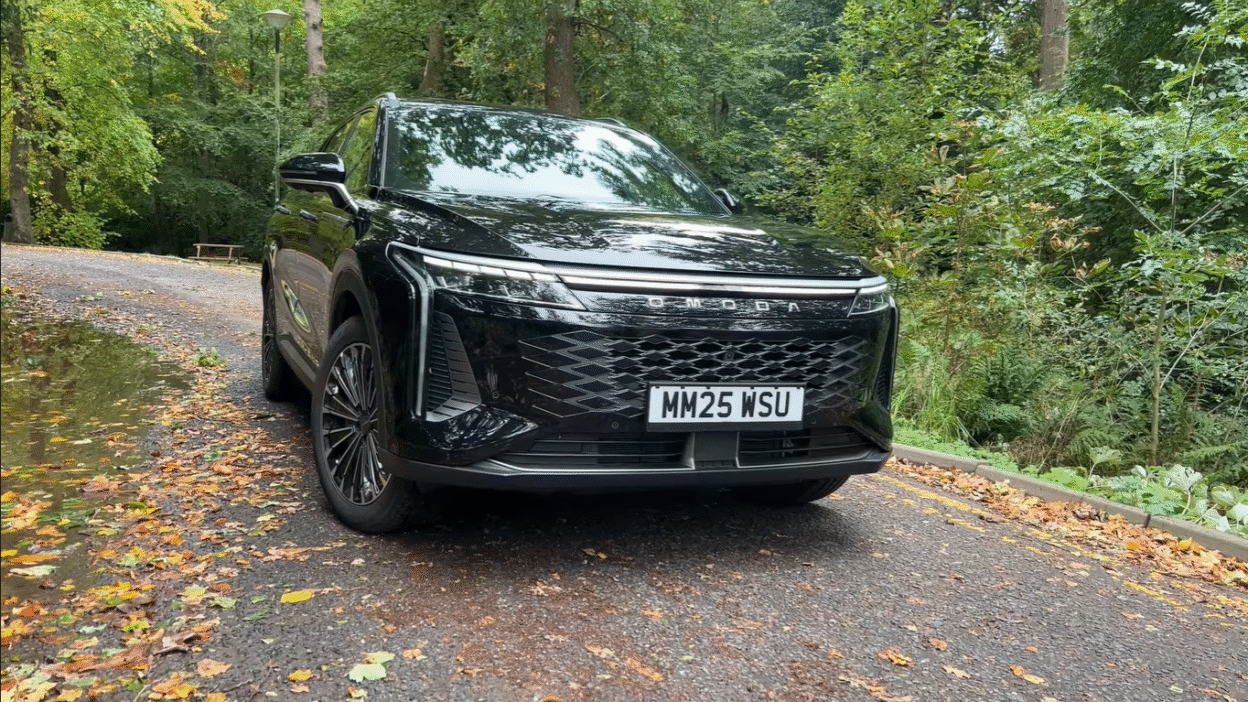🧠 TL;DR (Too Long; Didn’t Read)
The Omoda 9 SHS is a surprising new luxury SUV from Chinese automaker Chery’s Omoda sub-brand, aiming to compete with the likes of Kia Sportage, Hyundai Tucson, and even BMW X3—but at a fraction of the price.
It offers 443 hp, 93 miles of pure electric range, plush interiors, 540° camera tech, and a surprisingly premium cabin with features like heated/ventilated seats, panoramic roof, and Sony sound.
However, it’s not without flaws—brand unfamiliarity, average infotainment UX, and not-so-sporty driving dynamics could make some buyers hesitate.
Still, at under £46,000 (~$56,000) fully loaded, it’s one of the most value-packed plug-in hybrid SUVs of 2025.
Introduction: The Surprise Entry in the Luxury SUV Game
Every now and then, a car lands that doesn’t just enter the conversation — it hijacks it. The Omoda 9 SHS is that car. Built by Omoda, Chery’s premium global brand, this midsize plug-in hybrid SUV launched in 2025 with one clear mission: to offer Lexus-level refinement at Kia money.
Priced from £44,995 in the UK (and fully loaded in a single Noble trim), it comes with all-wheel drive, 20-inch alloys, Sony audio, adaptive suspension, and a panoramic roof — no tick-box options, no hidden extras. Under the skin, a 1.5-litre turbo petrol engine works with dual electric motors and a 34.5 kWh battery to produce 443 horsepower and 768 Nm of torque. That’s enough to hit 60 mph in 4.9 seconds and travel 93 miles on electric power alone — or nearly 700 miles with a full tank.
I drove it for a week through Scotland’s worst weather — storms, floods, and wind — and it never missed a beat. This review dives deep into design, performance, luxury, tech, and real-world driving. By the end, you’ll see why the Omoda 9 isn’t just good for the price. It’s good, full stop.
Exterior Design: Minimalist Elegance Meets Futuristic Details
The Omoda 9 doesn’t shout. It whispers — and people still turn around.
At just under 4.8 metres long, it’s sized like a Hyundai Tucson or Skoda Kodiaq, but styled with a cleaner, more confident hand. Up front, a horizontal LED light bar links sleek headlights, crossed by vertical strips that form a subtle T-shape. Lock or unlock the car, and the lights perform a brief choreographed sequence — a small touch that feels special every time.
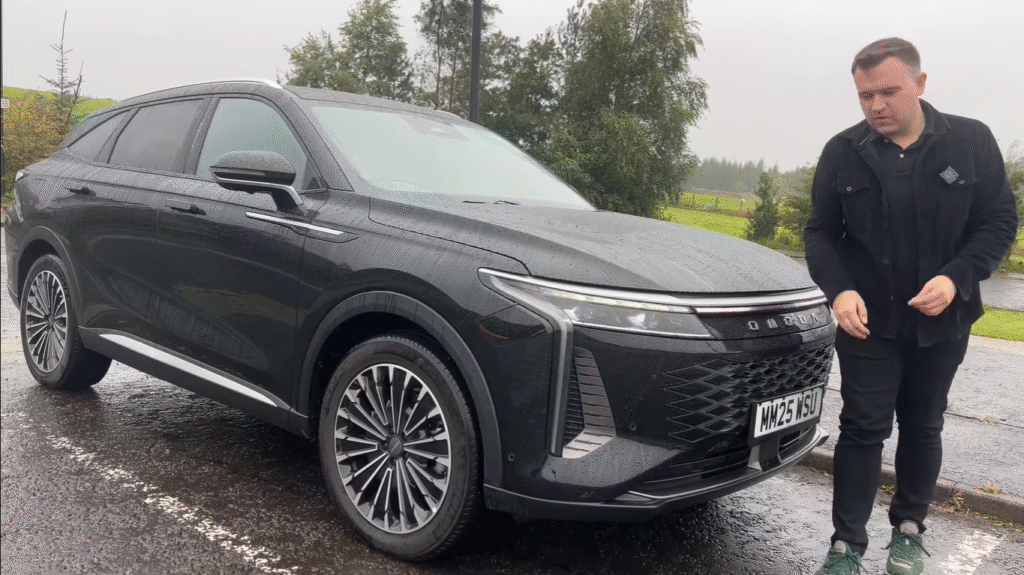

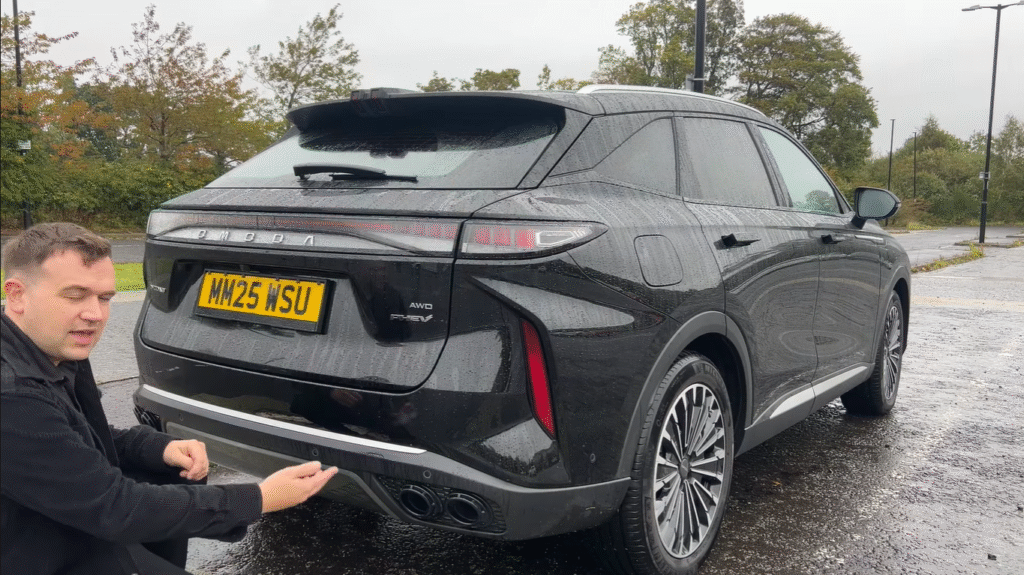
The grille spells out “OMODA” in chrome, framed by a rhombus pattern that flows into the lower bumper. It’s bold but not brash. At night, the daytime running lights cut a sharp, modern signature — clean, premium, and instantly recognisable.
Along the sides, the roofline slopes gently toward the rear, giving the car a dynamic, almost coupe-like stance. The 20-inch diamond-cut wheels — your only choice — sit on Michelin e-Primacy tyres tuned for efficiency and silence. Flush door handles pop out as you approach, and the doors extend slightly beyond the sills — a clever detail that keeps your clothes clean when stepping out in the rain.
At the back, the design gets playful. A full-width LED tail light starts thin at the edges and swells toward the centre, echoing a Porsche Cayenne. A tiny F1-style spoiler sits above, and fake quad exhausts hint at the performance within. They’re purely for show, but they work — I had strangers ask about the car all week. The electric tailgate lifts to reveal a 600-litre boot — deep, carpeted, and practical, with 60/40 split seats and space for the charging cable underneath.
It’s not revolutionary. But it’s cohesive, handsome, and distinctive — a car that looks expensive without trying too hard.
Powertrain & Performance: Hybrid Muscle with EV Serenity
Open the bonnet — supported by gas struts, a nice premium touch — and you’ll find the engine bay neatly insulated and organised. The heart of the Omoda 9 is a 1.5-litre turbocharged petrol engine paired with two electric motors and a 34.5 kWh battery. Together, they produce 443 hp and 768 Nm — numbers that sound like a typo in a family SUV.
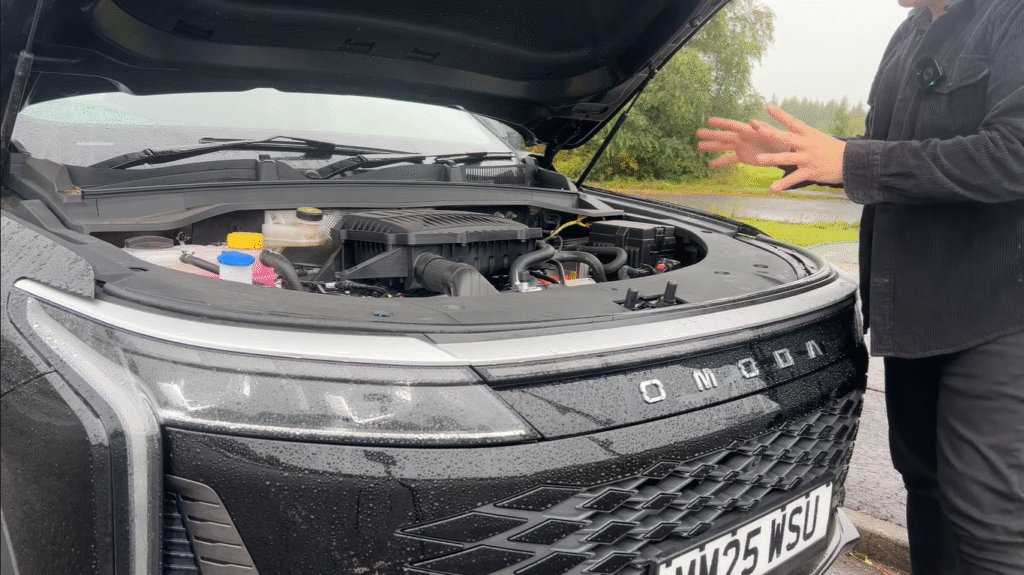
And yet, they’re not. From a standstill, the car launches forward with startling urgency. The electric motors deliver instant torque, and the petrol engine kicks in seamlessly when needed. 0–60 mph in 4.9 seconds feels entirely believable — I left several hot hatches behind at the lights without even trying.
The battery offers a WLTP-rated 93 miles of electric range. In the real world, I saw 70–80 miles in mixed conditions — more than enough for a daily commute. With a full tank, the total range approaches 700 miles. Charging is flexible: AC at home or DC rapid up to 70 kW, taking you from 10% to 80% in 25 minutes.
Efficiency impressed me. Over a week of city, motorway, and B-road driving, I averaged 81 mpg in hybrid mode and 5.2 miles per kWh in EV mode. The car prioritises electric driving until the battery drops below 20%, then blends power smoothly. You can force EV mode if you want silence — and in town, it’s eerily quiet.
All-wheel drive is standard, and it shows. On wet, slippery roundabouts, the car gripped confidently — no drama, no wheelspin (unless you really provoke it). Towing capacity is 1,500 kg braked — useful for a trailer or small caravan.
The Omoda 9 isn’t just powerful. It’s smart, efficient, and effortless — a powertrain that makes rivals look undercooked.
Interior: Quietly Luxurious, Unapologetically Premium
Step inside, and the Omoda 9 feels like it belongs in a higher price bracket. The cabin is spacious, light, and beautifully finished, with a sense of calm that’s rare at this money.
The full-length panoramic roof floods the interior with light, making the space feel airy and open. Both rows of seats are electrically adjustable — the driver gets six-way memory, the passenger four-way. The front seats are heated and ventilated, wrapped in quilted leather with red contrast stitching. They’re plush, supportive, and perfect for long journeys. The driver’s headrest even has a built-in speaker for phone calls and navigation — a quirky but useful touch.
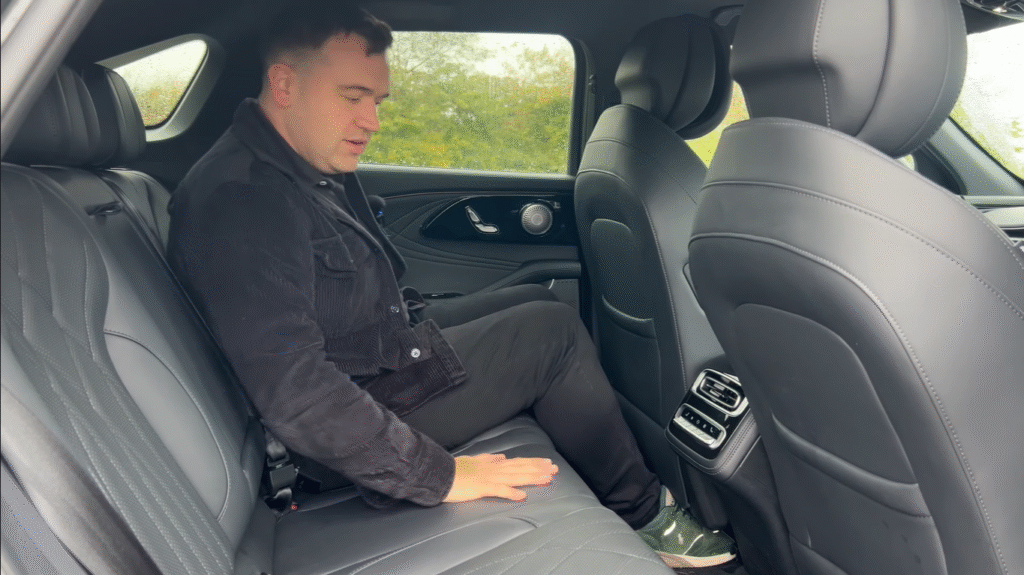
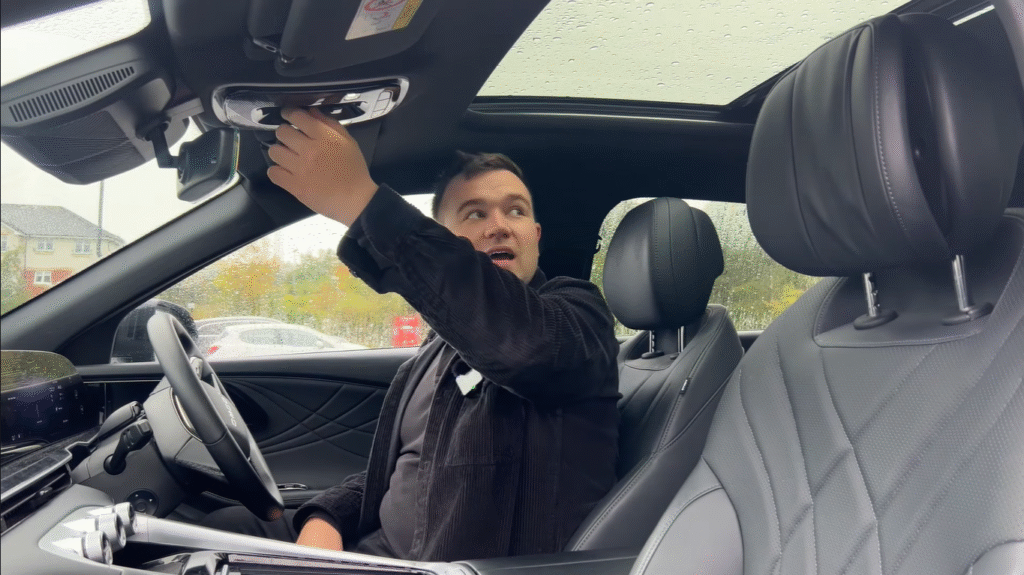
Rear passengers are well looked after. I’m 5’11”, and I had plenty of legroom and headroom, even behind my own driving position. The flat floor means the middle seat is actually usable, and the outer seats are heated. The backrests recline slightly, and the boxy rear design ensures no one feels cramped.
Materials are excellent throughout. The dashboard is covered in soft-touch vinyl, the door tops are padded, and the armrests are squidgy. Chrome accents and gloss black trim add sophistication without feeling cheap. There are no rattles, no creaks — just solid, premium build quality.
Storage is thoughtful. The centre console hides a cool box for drinks, the glovebox is deep and fuzzy-lined, and the door bins are split into compartments for bottles and odds and ends. USB ports are hidden behind flaps in the rear, and the driver gets a 12V socket while the front passenger has wireless charging.
The 600-litre boot is wide, flat, and powered, with underfloor storage for the charging cable. It’s ideal for shopping, suitcases, or airport runs.
A couple of small complaints: the passenger seat doesn’t adjust for height, which can feel odd for taller passengers, and the touchscreen is a slight stretch from the driver’s seat. But these are minor niggles in a cabin that feels closer to a Lexus than a Kia.
Infotainment & Features: Feature Overload
The Omoda 9 is packed with tech — and most of it actually works.
Two 12.3-inch screens dominate the dash: one for the driver, one for infotainment. Both are sharp, responsive, and easy to read. Wireless Apple CarPlay and Android Auto are standard, and the system supports voice control for climate, navigation, and more.
The standout feature is the 540° camera system — a 360-degree view with bird’s-eye and transparent chassis graphics. It’s genuinely useful in tight spaces, and the way it mimics your indicator direction on screen is clever and intuitive.
Other highlights include a clear heads-up display, adaptive cruise control, lane-keeping assist, and a driver attention monitor. The Sony 10-speaker audio system sounds rich and detailed, with physical shortcut buttons on the steering wheel.
Climate control is excellent. The system offers automatic defogging, air purification, and pre-cleaning modes, all controlled via the touchscreen or physical knobs for temperature and fan speed. Ambient lighting can be customised with dozens of colours and effects — pulsing, static, or two-tone.
There’s no start button — just press the brake with the key nearby, and the car wakes up. The drive selector is a stalk: up for reverse, down for drive, button for park. It takes a minute to get used to, but soon feels natural.
The only downside is that nearly everything is controlled through the touchscreen. It’s not a major issue, but it does require a brief learning curve. Once you’re familiar, though, the system is smooth, logical, and packed with useful features.
Driving Experience: Comfort Over Cornering
The Omoda 9 SHS is not a sports car. And that’s perfectly fine.
It’s a luxury cruiser — smooth, quiet, and effortlessly powerful. The adaptive suspension soaks up bumps with ease, and the cabin is beautifully insulated from wind and road noise. In EV mode, it’s near-silent; in hybrid mode, the petrol engine is muted and refined.
Power delivery is brisk and linear. The electric motors provide instant response, and the petrol engine blends in without fuss. I saw wheelspin in the wet a few times — not from lack of grip, but from the sheer torque on tap. The all-wheel-drive system keeps everything planted, even on flooded roads.
Steering is light and accurate, but not particularly communicative. Body roll is present in corners, but the car remains composed and predictable. This isn’t a BMW X3 — it’s not trying to be. It’s a comfort-first SUV, and it excels at that.
Drive modes include Eco, Normal, Sport, Snow, Sand, and Off-road. I stuck to Eco and Normal — Sport just makes the throttle sharper and the engine louder, without improving the experience. The ride is plush in town, stable on the motorway, and confident on B-roads.
In a week of storm driving, the Omoda 9 felt unflappable. It’s not exciting to drive — but it’s deeply relaxing, and that’s exactly what most buyers want.
Pricing, Warranty & Value: The Shock Factor
In the UK, the Omoda 9 SHS starts at £44,995 — or £45,995 with metallic paint. That’s it. One trim, fully loaded.
You get everything: the wheels, the roof, the sound system, the safety tech, the adaptive suspension. No options list. No surprises.
The warranty is strong: 7 years or 100,000 miles on the vehicle, 8 years on the battery. Service network is growing — over 50 dealers in the UK by 2026.
Compared to rivals, the value is staggering. The Kia Sportage PHEV starts at £43,000 but offers half the power and range. The Toyota RAV4 Prime is £48,000 with less performance. The Hyundai Tucson PHEV is similarly priced but far less capable.
Resale value and brand recognition are unknowns — but at this price, with this kit, the Omoda 9 is a no-brainer for anyone who values substance over badge.
Verdict: A Bold Debut That Overdelivers
The Omoda 9 SHS isn’t just a good car. It’s a statement.
It proves that Chinese luxury is no longer an oxymoron. It delivers supercar pace, Lexus comfort, and 700-mile range for the price of a mid-spec Sportage. The interior is beautiful, the tech is clever, and the driving experience is deeply relaxing.
Yes, there are quirks — the touchscreen reach, the passenger seat height, the unknown badge. But none of them detract from the core truth: this is a brilliant SUV.
If you can look past the logo, you’ll find a car that overdelivers in every way. Omoda didn’t just enter the game. It changed it.
Final Score: 9.2/10
“The Omoda 9 SHS isn’t trying to be German or Japanese. It’s confidently, unapologetically itself — and it’s brilliant at it.”
£44,995–£45,995 (UK, 2025) — one fully loaded trim.
Up to 93 miles (WLTP); 70–80 miles real-world.
Source: Omoda 9 SHS Review: The Surprise Luxury SUV Everyone’s Talking About!
